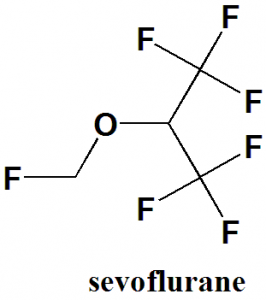SEVOFLURANE Synthesis, SAR, MCQ, Structure, Chemical Properties and Therapeutic Uses
Sevoflurane
IUPAC nomenclature
1,1,1,3,3,3-Hexafluoro-2-(fluoromethoxy)propane
Classification
Sevoflurane is an inhalational anesthetic.
Physiochemical Properties
| S. NO. | PHYSICAL AND CHEMICAL PROPERTIES | |
| 1 | Molecular weight | 200.05 g/mol |
| 2 | Physical appearance | Clear colourless liquid |
| 3 | Boiling point | 58.5°C |
| 4 | Solubility | Very slightly soluble in water. |
| 5 | Octanol/water partition coefficient | 2.4 |
| 6 | Presence of ring | Not present |
| 7 | Number of chiral centers | Not present |
Mechanism of Action
- Sevoflurane decreases the gap junction channel opening times and increases gap junction channel closing time which induces reduction in junctional conductance.
- The drug also increases the fluidity of the lipid membrane and thus, activates calcium dependent ATPase in the sarcoplasmic reticulum.
- Sevoflurane also binds with D subunit of ATP synthase, GABA receptors, glutamate receptors , glycine receptors, the large conductance Calcium ion activated potassium channel and NADH dehydrogenase.
Structure Activity Relationship
The SAR for inhaled anesthetics can be summarized as follows:
- Halogenations of the hydrocarbons and ether increase the anesthetic potency.
- Halogenations of the hydrocarbons tends to induce arrhythmia in the following order F<Cl<Br<I.
- Due to presence of asymmetric halogenated carbon in ether, they are better anesthetics.
- Halogenated methyl ethyl ethers are more stable, more potent and have better clinical profile than halogenated diethyl ether.
- Fluorination increases the stability and decreases the flammability.
- Compete halogenations of the alkane or ether decreases the anesthetic potency and increases the convulsant potency
- Presence of double bond increases chemical reactivity and toxicity.
Method of synthesis
Sevoflurane can be synthesised by fluoroalkylation of hexafluoroisopropyl alcohol using formaldehyde and HF in presence of fuming sulfuric acid.
Therapeutic Uses
Sevoflurane is used for:
- Induction and maintenance of general anesthesia in adult and pediatric patients.
Side Effects
Side effects of sevoflurane are:
- Bradycardia
- Hypotension
- Tachycardia
- Agitation
- Laryngospasm
- Airway obstruction
- Breath holding
- Cough increased
- Apnea
- Fever
- Shivering
- Hypothermia
- Headache
- Somnolence
- Dizziness
- Increased salivation
- Nausea
- Vomiting
- Asthenia
- Pain
- Confusion
- Dry mouth
- Insomnia
MCQs
Q.1 Choose the correct statements related with the physicochemical properties of drug Sevoflurane.
I. Molecular weight = 200.05 gm/mol
II.It is white crystalline solid
III. Melting point is 58.5oC
IV. It is very slightly soluble in water
a) I, III, IV
b) II, IV
c) I, IV
d) I, II, IV
Q.2 Match the following of the drugs with their correct IUPAC names.
| i. Sevofluran | A. 7-nitro-5-phenyl-1H-benzo[e][1,4]diazepin-2(3H)-one |
| ii. Nitrazepam | B. 2-[(Aminocarbonyl)oxy]-N,N,N-trimethylethanaminium chloride |
| iii. Carbachol | C. (±)-1-cyclohexyl-N-methylpropan-2-amine |
| iv. Propylhexedrine | D. 1,1,1,3,3,3-Hexafluoro-2-(fluoromethoxy)propane |
a) i-C, ii-A, iii-B, iv-D
b) i-D, ii-A, iii-C, iv-B
c) i-D, ii-A, iii-B, iv-C
d) i-A, ii-C, iii-B, iv-D
Q.3 Which amongst the following are the correct statement related with the mechanism of action of drug sevoflurane?
I. Decreases the gap junction channel opening time
II. Reduction in junctional conductance
III. Decrease in fluidity of the lipid membrane
IV. Decreases the gap junctional channel closing time
a) I – II
b)II – III
c) III – I
d) IV- II
Q.4 Correct sequence for True/false for the classification of the drug can be?
- Sevoflurane: inhalational anesthetic
- Dobutamine: ß1-adrenergic agonist
- Phentolamine: Nonselective adrenergic agonist
- Clonidine: Selective α1-adrenergic agonist
a) TFFT
b) TTTT
c) TTFF
d) FFTF
Q.5 Fluorination of the inhalatioal anesthetics?
a) Decreases stability
b) Increases the flammability
c) Increases the stability
d) Both b) and c)
Q.6 Hexafluoroisopropyl alcohol can be converted into sevoflurane by?
I. Fluoroalkylation
II. Methylation
III. Sulfonation
IV. Hydrogenation
a) IV – I
b) I
c) I – III
d) III – II
Q.7 Side effect of drug Sevoflurane include?
a) Bradycardia
b) Somnolence
c) Increased salivation
d) All of the above
Participate in Online FREE GPAT TEST: CLICK HERE
Participate in Online FREE Pharmacist TEST: CLICK HERE
Participate in Online FREE Drug Inspector TEST: CLICK HERE
ANSWERS
1-a
2-c
3-a
4-c
5-d
6-b
7-d

